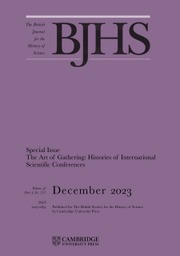No CrossRef data available.
Article contents
Warwick Anderson, Spectacles of Waste Cambridge: Polity, 2024. Pp. 184. ISBN 978-1-509-55741-7. £14.99 (paperback).
Review products
Warwick Anderson, Spectacles of Waste Cambridge: Polity, 2024. Pp. 184. ISBN 978-1-509-55741-7. £14.99 (paperback).
Published online by Cambridge University Press: 09 December 2024
Abstract
An abstract is not available for this content so a preview has been provided. Please use the Get access link above for information on how to access this content.

Information
- Type
- Book Review
- Information
- The British Journal for the History of Science , Volume 58 , Issue 3 , September 2025 , pp. 569 - 570
- Copyright
- © The Author(s), 2024. Published by Cambridge University Press on behalf of British Society for the History of Science


